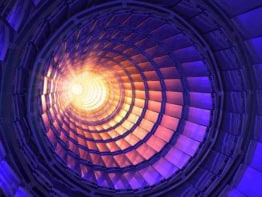An international team of physicists has reported what it describes as the most significant deviation to date between experiment and theory in particle physics. Measurements of how muons wobble in a magnetic field offer the clearest hint so far of new physics beyond the Standard Model of particle physics. The findings were announced today by the muon g-2 collaboration at Brookhaven National Laboratory in the US.
The muon g-2 experiment measures the “g-factor” that relates the spin of the muon – a particle that is 208 times heavier than an electron – to its magnetic moment. Simple quantum theories predict that g=2 for particles such as electrons and muons. However, radiative corrections caused by the continuous emission and re-absorption of short-lived virtual particles means that g is not exactly equal to 2.
These corrections can be caused by particles that are part of the Standard Model, or by more exotic particles that are not included in the model. Probing the differences between experimental results and theoretical predictions is therefore a good way to search for new physics beyond the Standard Model. The leading candidate for such new physics is supersymmetry – a theory which predicts that all the particles in the Standard Model have so-called superpartners.
The Brookhaven experiment has already observed such differences for the g-2 value of positive muons, which have now been confirmed by the first g-2 measurements for negative muons. The latest measurement, which matches the combined precision of the previous results, differs from theory by 2.9 standard deviations. If all three results are combined, the difference between theory and experiment is 2.8 standard deviations.
“The fact that our measurement continues to deviate from theory may be an indication that we are seeing new physics beyond the Standard Model,” said Lee Roberts of Boston University, spokesperson for the experiment. “Our experiment is now 14 times more precise than the first muon g-2 experiment performed at CERN in the 1970s – and this precision places important restrictions on potential new theories”.
“The recent g-2 result strengthens the case for new physics effects, with supersymmetry a leading candidate, but it is by no means definitive,” says William Marciano, a theorist at Brookhaven. “Continued scrutiny of theory and further running of the experiment are imperative.”
The muon g-2 team – which includes physicists from the US, Russia, Japan, the Netherlands and Germany – has submitted its result to Physical Review Letters.



